NASA’s Parker Solar Probe is on its way for a rendezvous with the Sun.
 A United Launch Alliance Delta IV Heavy rocket, carrying the spacecraft, lifted off on Saturday night from Space Launch Complex 37 on Cape Canaveral Air Force Station in Florida, its engines blazing in the clear night sky during ascent.
A United Launch Alliance Delta IV Heavy rocket, carrying the spacecraft, lifted off on Saturday night from Space Launch Complex 37 on Cape Canaveral Air Force Station in Florida, its engines blazing in the clear night sky during ascent.
“It was a very quiet launch countdown, it went off like clockwork,” says Omar Baez, NASA launch director. “Parker Solar Probe has been one of our most challenging missions to date. I’m very proud of the team that worked to make this happen. We at NASA and the Launch Services Program are thrilled to be part of this mission.”
About four minutes into flight, a series of key events occurred. The Delta IV port and starboard booster engines shut down and separated, the main core booster engine cut off and then separated from the second stage. After second stage engine ignition, the payload fairing was jettisoned. After second stage main engine cutoff and separation, the Parker Solar Probe separated from the third stage, provided by Northrup Grumman.
Shortly afterward, mission managers confirmed that the spacecraft’s solar arrays successfully deployed and the spacecraft was operating on its own power.
During its mission to “touch” the Sun, Parker Solar Probe will use gravity assists from Venus seven times over nearly seven years to gradually bring its orbit closer to the Sun.
It will fly directly through the Sun’s atmosphere, as close as 3,8-million miles from its surface, closer to the surface than any spacecraft before it.
The spacecraft will hurtle around the Sun at speeds up to 430 000 miles per hour – 15-times faster than a speeding bullet.
Parker Solar Probe will revolutionise our understanding of the Sun’s corona. Facing brutal heat and radiation, the spacecraft will fly close enough to watch the solar wind speed up from subsonic to supersonic, and fly through the birthplace of the highest-energy solar particles.
Parker Solar Probe and its instruments will be protected from the Sun’s heat by a 4,5-inch-thick, carbon-carbon composite heat shield. The shield’s front surface will be able to withstand temperatures outside the spacecraft up to 2 500 degrees Fahrenheit, while the inside, or back, surface of the shield will withstand temperatures up to 650 degrees Fahrenheit.
For more than 60 years, scientist have wondered how energy and heat move through the solar corona and what accelerates the solar wind as well as solar energetic particles. Now, with the help of cutting-edge thermal technology that can protect the mission on its dangerous journey, the spacecraft’s four instrument suites will study magnetic fields, plasma and energetic particles, and image the solar wind.
In 2017, the mission was renamed for Eugene Parker, the S Chandrasekhar Distinguished Service Professor Emeritus, Department of Astronomy and Astrophysics at the University of Chicago. In the 1950s, Parker, a solar astrophysicist, proposed a number of concepts about how stars–including our Sun–give off energy. He called this cascade of energy the solar wind, and he described an entire complex system of plasmas, magnetic fields, and energetic particles that make up this phenomenon.
Parker also theorised an explanation for the superheated solar atmosphere, the corona, which is – contrary to what was expected by physics laws – hotter than the surface of the Sun itself.

